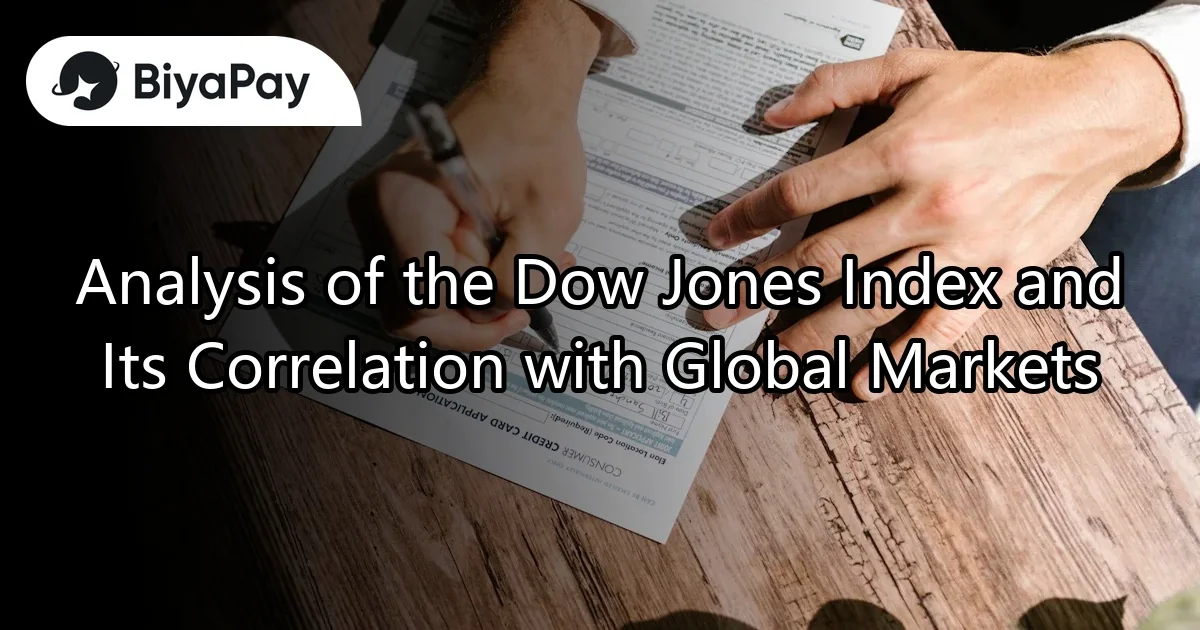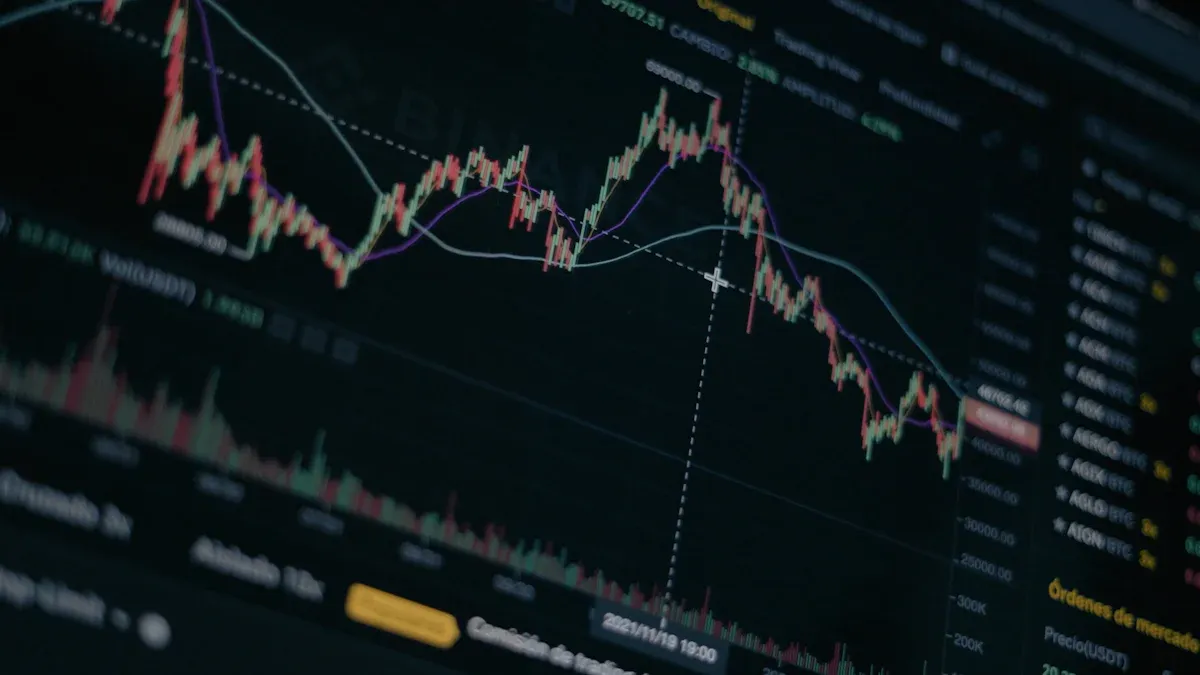- EasyCard
- Trade
- Help
- Announcement
- Academy
- SWIFT Code
- Iban Number
- Referral
- Customer Service
- Blog
- Creator
Analysis of the Dow Jones Index and Its Correlation with Global Markets

Image Source: unsplash
The U.S. Dow Jones Index plays a significant role in global markets, with its fluctuations often revealing the latest economic trends. Recent statistics show that when the Dow Jones Index plummeted by 1,679 points, other major indices such as the Nasdaq and Philadelphia Semiconductor Index also experienced significant declines, fully reflecting market interconnectedness. Additionally, the index has recently been trading within a high range, indicating investors’ expectations for trade negotiations. According to forecasts, May’s overall CPI inflation is expected to rise from 2.3% to 2.5%, while core CPI inflation is projected to increase from 2.8% to 2.9%. These changes not only reflect the latest dynamics of the U.S. economy but may also have profound impacts on global markets.
Latest Market Dynamics of the U.S. Dow Jones Index

Image Source: pexels
Recent Index Trends
The U.S. Dow Jones Index has recently performed steadily, approaching 43,000 points, reflecting market expectations for a U.S.-China trade agreement. Investors are closely monitoring the upcoming U.S. Consumer Price Index (CPI) data, which may influence market sentiment and lead to index fluctuations. Core annualized CPI inflation is expected to rise from 2.8% to 2.9%, exceeding the Federal Reserve’s target, which may prompt investors to reassess risks.
- The Dow Jones Index has recently risen, approaching 43,000 points, showing market expectations for a U.S.-China trade agreement.
- This week’s upcoming CPI inflation data may impact market sentiment and cause index fluctuations.
- Core annualized CPI inflation is expected to rise from 2.8% to 2.9%, above the Federal Reserve’s target.
Major Events Influencing the Index
Several recent events have significantly impacted the U.S. Dow Jones Index. The composite PMI fell to a 17-month low, indicating slowing economic growth and a contracting service sector. Tariff policies have increased cost pressures on businesses, affecting profit margins. The employment index dropped to 49.4, reflecting persistent pessimism among businesses about future prospects. Corporate confidence has sharply declined due to geopolitical uncertainties and government spending cuts, further dragging down market performance.
- The composite PMI fell to a 17-month low, indicating slowing economic growth.
- Tariff policies have increased cost pressures, impacting corporate profits.
- The employment index dropped to 49.4, reflecting corporate pessimism about future prospects.
- Corporate confidence declined due to geopolitical uncertainties and government spending cuts.
Role of Market Sentiment
Market sentiment plays a crucial role in the fluctuations of the U.S. Dow Jones Index. AAII’s investor sentiment survey data provides quantitative indicators to help gauge future market directions. These data are often viewed as contrarian indicators: when market sentiment is overly bullish, the stock market may face corrections, and vice versa. Changes in investor sentiment directly influence market buying and selling behaviors, further amplifying index fluctuations.
- AAII’s investor sentiment survey data can quantify market sentiment.
- When market sentiment is overly bullish, the stock market may face corrections.
- Changes in investor sentiment affect market buying and selling behaviors, amplifying index fluctuations.
Impact of Global Market Factors on the U.S. Dow Jones Index

Image Source: pexels
U.S.-China Trade Progress
Progress in U.S.-China trade relations has profoundly influenced market expectations for the U.S. Dow Jones Index. Recent data show that China’s export volume has grown, while imports have significantly declined, leading to a narrowed trade deficit. These changes reflect adjustments in global supply chains and fluctuations in market demand.
Below is the specific performance of recent U.S.-China trade data:
| Indicator | Value | Change |
|---|---|---|
| Import Volume | USD 276.097 billion | Down 19.8% from the previous month |
| Trade Deficit | USD 87.6 billion | Significantly narrowed |
| Export Volume | USD 188.473 billion | Up 3.4% |
These data indicate that China’s export growth may enhance the stability of U.S. companies’ supply chains, thereby influencing investor confidence in the U.S. Dow Jones Index. However, the decline in imports may reflect weakening domestic demand in the U.S., further exacerbating market uncertainty.
Inflation and Interest Rate Policies
Inflation and interest rate policies are critical factors affecting the U.S. Dow Jones Index. According to UBS analysis, the latest inflation data show that U.S. inflation has significantly slowed, providing the Federal Reserve with more policy flexibility. This trend may alleviate market concerns about monetary tightening, stabilizing investor sentiment.
- The latest inflation data show that CPI and PPI have further slowed, reducing expectations for rate hikes.
- Slower inflation provides the Federal Reserve with more policy flexibility, potentially boosting stock markets.
- The S&P 500 Index rose slightly by 1.2% year-to-date, reflecting positive market reactions to inflation data.
Adjustments to interest rate policies are closely tied to inflation data. When inflation rates decline, the Federal Reserve may choose to maintain or lower rates, directly affecting corporate financing costs and market liquidity, further influencing the performance of the U.S. Dow Jones Index.
Consumer Confidence Index
The consumer confidence index is an important indicator of market sentiment. Recent data show that the index plunged by 14%, reaching a historic low of 50.2, reflecting public pessimism about the economy. This sentiment may directly impact the fluctuations of the U.S. Dow Jones Index.
- The consumer confidence index dropped to 50.2, reflecting concerns about economic recession.
- When economic data indicate a recession, the correlation between market sentiment and index fluctuations becomes more pronounced.
- Investors’ pessimistic expectations about future economic prospects may lead to stock market declines.
A decline in consumer confidence typically suppresses consumer spending, further affecting corporate revenues and profitability. These factors ultimately manifest in the performance of the U.S. Dow Jones Index, becoming a significant driver of market volatility.
Application of Technical and Fundamental Analysis
Technical Analysis Tools
Technical analysis tools help investors gauge market trends and price movements. Commonly used tools include moving averages, the Relative Strength Index (RSI), and Bollinger Bands. Moving averages display long-term price trends, helping investors identify support and resistance levels. RSI is used to measure overbought or oversold conditions, providing short-term trading signals. Bollinger Bands analyze volatility to help investors determine whether prices deviate from normal ranges. Combining these tools enhances analysis accuracy, providing investors with more comprehensive market insights.
Key Points of Fundamental Analysis
Fundamental analysis focuses on assessing the intrinsic value of companies and economies. Investors typically reference the following data to understand the fundamental drivers behind index fluctuations:
- U.S. Consumer Spending
- Labor Market Conditions
- Corporate Earnings Growth Rates
- Economic Growth Forecasts
For example, U.S. consumer spending reflects the strength of market demand, directly affecting corporate revenues and profitability. Labor market conditions indicate the economy’s health, influencing consumer confidence and investor sentiment. Corporate earnings growth rates provide an indicator of operational efficiency, helping investors assess a stock’s potential value. Economic growth forecasts reveal future macroeconomic trends, impacting overall market performance. By analyzing these data, investors can more accurately evaluate the causes of U.S. Dow Jones Index fluctuations and future trends.
Combining Methods for Investment Decisions
Combining technical and fundamental analysis enhances the effectiveness of investment decisions. Technical analysis provides guidance on short-term market trends, while fundamental analysis reveals long-term value potential. Investors can first use technical analysis tools to identify optimal entry and exit points, then rely on fundamental data to confirm the soundness of investment targets. For instance, when technical analysis indicates a price breakout above resistance levels, investors can reference fundamental data to determine whether the stock has long-term growth potential. This combined approach helps investors make more rational decisions in volatile markets.
Future Outlook for the U.S. Dow Jones Index
Short-Term and Medium-Term Forecasts
In the short term, the U.S. Dow Jones Index may continue to be influenced by economic data and policy changes. According to recent market analysis, investors will closely monitor the Federal Reserve’s interest rate decisions and upcoming employment reports. If inflation data further slow, the market may experience a short-term rebound. However, if economic data indicate slowing growth or declining corporate earnings, the index may face pressure.
In the medium term, geopolitical risks and global supply chain changes will be major influencing factors. Progress in U.S.-China trade negotiations may alter market expectations, particularly impacting technology and manufacturing sectors. Investors should monitor these factors for potential impacts on the market and adjust portfolios to address possible volatility.
Investment Strategy Recommendations
In the current market environment, investors should adopt diversified investment strategies to reduce risks. Below are some recommendations:
- Diversified Investments: Allocate funds across different industries and regions to mitigate the impact of single-market fluctuations.
- Focus on Defensive Assets: Such as utilities and healthcare sectors, which typically perform steadily during economic uncertainty.
- Regular Portfolio Reviews: Adjust asset allocations based on market changes to ensure alignment with investment goals and risk tolerance.
Additionally, combining technical and fundamental analysis helps investors more accurately gauge market trends. Using technical tools to identify short-term trends and fundamental data to assess long-term value enhances decision-making effectiveness.
Long-Term Market Trends
From a long-term perspective, the performance of the U.S. Dow Jones Index will depend on global economic growth and technological innovation. As artificial intelligence, green energy, and digital transformation accelerate, related industries may become key market growth drivers.
Furthermore, demographic changes and sustainability demands will influence corporate business models and investor preferences. Investors should focus on these long-term trends and consider allocating funds to industries with growth potential.
Experts suggest that long-term investors maintain patience and avoid excessive adjustments due to short-term volatility. Sound asset allocation and a deep understanding of market trends are key to success.
The interconnectedness of the U.S. Dow Jones Index with global markets is evident. Its fluctuations not only reflect the health of the U.S. economy but also reveal global market dynamics. In the future, the index may continue to influence investor decisions due to technological innovation and geopolitical changes. Experts recommend that investors combine technical and fundamental analysis to develop rational and robust investment strategies to address market uncertainties.
Investors should remain patient, avoiding excessive strategy adjustments due to short-term volatility. Robust analysis and diversified investments are key to success.
FAQ
Does the Dow Jones Index Accurately Reflect the U.S. Economy?
The Dow Jones Index reflects part of the U.S. economy but is not a comprehensive indicator. It primarily covers the performance of large companies, failing to fully represent small and medium-sized enterprises or other industries.
How Do Global Market Fluctuations Affect the Dow Jones Index?
Global market fluctuations impact the Dow Jones Index through trade, monetary policies, and geopolitical factors. U.S.-China trade progress and international oil price changes are often key drivers of index volatility.
How Can Investors Use Technical Analysis Tools to Gauge Dow Jones Index Trends?
Technical analysis tools like moving averages and RSI help investors gauge market trends. Moving averages show long-term trends, while RSI provides short-term trading signals, assisting in strategy formulation.
How Does Inflation Data Affect the Dow Jones Index?
Inflation data influence the Federal Reserve’s interest rate policies, thereby affecting the Dow Jones Index. Slower inflation typically boosts market sentiment, while rising inflation may pressure the index.
How Should Investors Address Dow Jones Index Volatility?
Investors should adopt diversified strategies to spread risks. Combining technical and fundamental analysis, regularly reviewing portfolios, and adjusting asset allocations based on market changes help address volatility.
In 2025, the Dow Jones Industrial Average hovers near 43,000, driven by US-China trade progress, rising CPI inflation to 2.9%, and weakening consumer confidence, amplifying global market linkages—how can you capitalize on US market potential while managing volatility risks? BiyaPay offers an all-in-one financial platform, enabling seamless trading of US tech and healthcare sectors and Hong Kong financial and tech assets without offshore accounts, helping you diversify risk and seize global opportunities.
Supporting USD, HKD, and 30+ fiat and digital currencies, real-time exchange rate tracking ensures cost transparency, while global remittances to 190+ countries feature transfer fees as low as 0.5%, significantly below traditional banks’ average 7.45%, with swift delivery to meet digital finance needs. A 5.48% annualized yield savings product, with no lock-in period, provides flexibility to navigate inflation and market swings. Sign up for BiyaPay today to integrate Dow Jones investment potential with BiyaPay’s worldwide financial solutions, creating an efficient, low-risk wealth management experience!
*This article is provided for general information purposes and does not constitute legal, tax or other professional advice from BiyaPay or its subsidiaries and its affiliates, and it is not intended as a substitute for obtaining advice from a financial advisor or any other professional.
We make no representations, warranties or warranties, express or implied, as to the accuracy, completeness or timeliness of the contents of this publication.




Contact Us
Company and Team
BiyaPay Products
Customer Services
is a broker-dealer registered with the U.S. Securities and Exchange Commission (SEC) (No.: 802-127417), member of the Financial Industry Regulatory Authority (FINRA) (CRD: 325027), member of the Securities Investor Protection Corporation (SIPC), and regulated by FINRA and SEC.
registered with the US Financial Crimes Enforcement Network (FinCEN), as a Money Services Business (MSB), registration number: 31000218637349, and regulated by FinCEN.
registered as Financial Service Provider (FSP number: FSP1007221) in New Zealand, and is a member of the Financial Dispute Resolution Scheme, a New Zealand independent dispute resolution service provider.



















